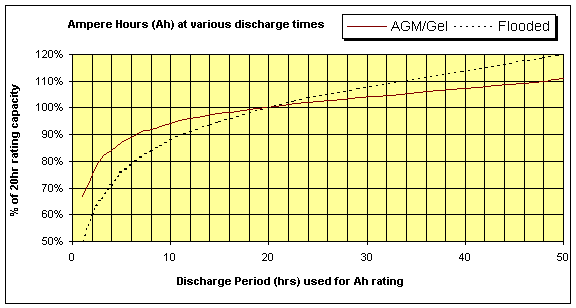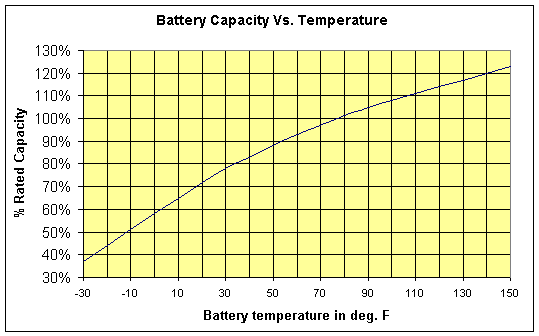As an example, a 200Ah (20
hr rate) battery can sustain a 10-Amp draw for 20 hours before reaching
100%DOD. 10 Amps X 20 hours = 200Ah. You may say that this same 200Ah
battery
should last 4 hours with a 50Amp draw, but this is not the case at all.
The
reason for this non-linearity is that the capacity of a battery
actually
decreases when the load increases. Take a look at fig. 1
to understand
how the Ah ratings vary depending on the discharge period.

fig. 1
Let’s use the example
above
of a 200Ah battery and see what its Ah capacity would really be for a
4-hour
discharge period. Using the chart, find the 4-hour mark and follow it
up
vertically until you cross the flooded battery curve. Then follow the
horizontal line across until you reach a percentage. In our example the
4-hour
line intersects the flooded battery curve at about 70%. This means the
battery
has 70% of the capacity it had when discharged at the 20 hour rate.
This comes
to 140Ah or a 35 Amp draw, quite a bit lower than the 50 Amp draw
expected.
200Ah
X 70% = 140Ah @ (4-hr rate)
140Ah
/ (4-hr rate) = 35 Amps
As you may have noticed, if
we chose an AGM or Gel type battery, we would have had 84% of our
original
200Ah, or 168Ah (4-hr rate). This means we could draw 42 Amps from the
battery
for 4 hours. Does this mean that AGM or Gel cell batteries are always
better?
In short the answer is no, not in all applications. All batteries have
their
strengths and weaknesses and it is beyond the scope of this article to
explain
them.
When shopping for a battery,
do not try to compare batteries with Ah ratings based on the 20hr rate
with
batteries based on a 100hr rate. Flooded batteries may have between 25%
to 40%
larger Ah ratings when using the 100hr rate vs. their 20hr rate. AGM
and Gel
cells may have 20% to 25% higher Ah ratings if they were based on the
100hr
rate vs. their 20-hour rate. To keep yourself from being confused,
always use
the 20hr rate when designing home power battery storage.
So how long can we run a 50
Amp load on a 200 Ah flooded battery? How does 2.5 hours
sound?
2.5Ah rate = 63% capacity X 200Ah = 126Ah (2.5hr rate). 126Ah / 2.5hrs
= 50.4
Amps! Hey we have a little room to spare, or do we?
How about throwing a few more
wrenches into the works
by talking about some other factors that effect battery capacity. The
largest
factor is battery life. The deeper you discharge a battery during
normal use,
the shorter its overall life span will be. In the examples above, we
discharged
the battery to 100% DOD. Repeatedly discharging a battery to this depth
will
severely shorten its lifespan. Although you can periodically cycle a
battery
down to 80% DOD with virtually no damage to the battery, it will still
shorten
its life if done on a regular basis.
Most deep cycle battery
manufacturers recommend a Depth Of Discharge of 50%. This is a good
compromise
between battery life, storage capacity, and economics. In our example
above
this immediately cuts our 200 Ah battery down to 100 Ah if we want it
to have a
good life span.
Let’s talk about
another factor and that is battery
temperature. In general, a warmer battery has a higher capacity. The
opposite
is also true; a colder battery has a lower capacity. If taken to
extremes, the
battery may be damaged by excessive heat or cold. Take a look at fig.
2
to see how capacity is affected by temperature.

Fig. 2
If we were to use our
200 Ah
battery outside in winter and the battery’s temperature was
just above
freezing, say 34 deg F. We could use the chart to see what kind of
capacity we
could expect from it. Find 34 degrees and follow it up to the capacity
curve
and we see that the capacity of the battery is only 80% of normal.
200Ah X 80% = 160Ah
To go a step further lets
say we wanted to only discharge our battery to 50%. So our 200Ah
battery now
becomes an 80 Ah battery when used in the cold near freezing. One nice
advantage about cold batteries is that their useful life is extended.
Conversely, if a battery is always hot, its life will be shortened.
Most
installations see both hot and cold, so the life expectancy pretty much
evens
out. Bottom line is, give your batteries a sheltered place to live that
will
limit the temperature extremes.
Two other factors that greatly
influence battery
capacity are charging and maintenance.
Over and under charging of deep cycle batteries is the most common
cause of premature loss of capacity.
Overcharging can “boil off” the electrolyte leaving
the plates
high and dry in a flooded
battery. In the case of gel cell batteries, permanent damage can occur
if the
maximum charge voltage is exceeded and pockets of gas deform the gel
around the
plates.
Undercharging can cause a buildup of lead sulfate on the
battery
plates. When you bring a battery back to full charge each cycle, the
lead
sulfate is recombined into the plates and electrolyte. Never leave or
store a
battery in a semi-charged state, keep the batteries charged if not in
use. Stored batteries can be left on a trickle charge or at
least topped
off every couple of months. Always follow the battery manufacturers
recommendations for charging and maintenance to ensure maximum capacity
and
life.
Hopefully this information will
make more sense out of
the battery sizing worksheets and why it is important to select a
battery bank
size that is correct for your installation.